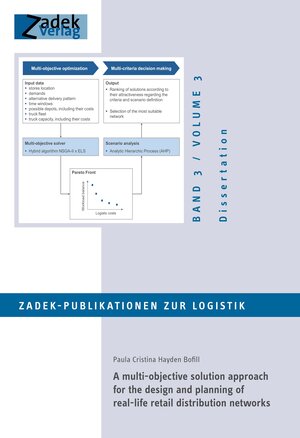
Managers in retail sites, who are responsible for the design and planning of secondary distribution networks. The solution approach might be applied to plan new distribution networks or to optimize already existing networks.
A multi-objective solution approach for the design and planning of real-life retail distribution networks
von Paula Cristina Hayden Bofill, herausgegeben von Hartmut ZadekAbstract:
This research proposes a two-step solution approach for the design and planning of real-life secondary distribution networks in the chain store retail sector. The first step handles the optimization problem, which includes planning decisions regarding warehouse selection, store-warehouse allocation, the selection of delivery patterns, and the design of round trips for the replenishment of the stores considering service time windows. Moreover, the costoptimization problem is turned into a multi-objective optimization problem by including the objective of balancing the workload of the warehouses throughout the week. The aim of the cost-workload optimization is to identify promising network configurations with structural or operational differences that are used as input for the second step. Hybrid modern heuristics are proposed for both the cost-optimization and the cost-workload optimization. The second step supports the decision maker in the selection of the most suitable solution from the Paretooptimal set for particular scenarios. The suitability of the two-step solution approach for reallife operations as well as the benefits of more balanced operations is tested using a real-life
case study.








